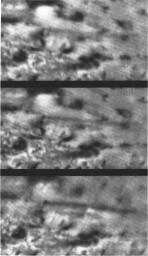
|
Triton’s Volcanic Plumes
- Click the image above for a larger view
- Full-Res JPEG (900 x 1558) (191.5 kB)
- Full-Res TIFF (900 x 1558) (1.4 MB)
Caption:
These three sequential images of an erupting volcano on Neptune's large moon Triton were taken by NASA's Voyager 2 as the spacecraft approach the moon on Aug. 26, 1989. The images, taken about 45 minutes apart (top to bottom), show the geyser-like volcanic plume spewing an eight kilometer- (five mile-) tall cloud of fine, dark particles into Triton's thin atmosphere. The cloud can be seen drifting downwind to the right for a distance of roughly 150 kilometers (about 100 miles). In the last view (bottom), the shadow of the lound cloud can be distinguished. The density of the cloud appears to increase through the sequence of images; whether this change was real or whether the cloud simply appears to grow when viewed from different angles is uncertain. Voyager scientists say one explanation for the mechanism that drives such eruptions is that sunlight absorbed by dark particles inside Triton's ice cap warms nitrogen ice, causing the pressure of nitrogen gas to increase. The pressurized gas then escapes through vents, carrying aloft with it dark, powdery particles that are left suspended to drift downwind. Triton, Eath, and Jupiter's moon Io are the only three objects in the solar system known to have active volcanos.
Background Info:
The Voyager Project is managed for NASA by the Jet Propulsion Laboratory, Pasadena, Calif.
Cataloging Keywords:
| Name | Value | Additional Values |
|---|---|---|
| Target | Triton | |
| System | Neptune | |
| Target Type | Satellite | |
| Mission | Voyager | |
| Instrument Host | Voyager 2 | |
| Host Type | Flyby Spacecraft | |
| Instrument | ||
| Detector | ||
| Extra Keywords | Atmosphere, Grayscale, Plume, Shadow, Volcano | |
| Acquisition Date | ||
| Release Date | 1989-10-27 | |
| Date in Caption | 1989-08-26 | |
| Image Credit | NASA/JPL | |
| Source | photojournal.jpl.nasa.gov/catalog/PIA14449 | |
| Identifier | PIA14449 | |
